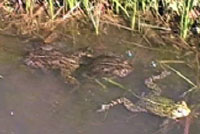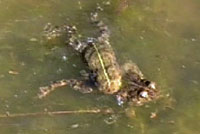
A Guide to California's
Reptiles and Amphibians
Sounds of
California Toad - Anaxyrus boreas halophilus
(Baird and Girard, 1852)(= Bufo boreas halophilus)


| Male California Toads do not have a pronounced vocal sac, but they do make a call during breeding aggregations. Their call has been described as a high-pitched plinking
sound, like the peeping of a chick, repeated several times. Since it is not made to attract distant females, the call is not very loud when compared to the call of the sympatric Pacific Treefrog (or similar treefrog species.) The sound of a group of males calling has been compared to the sound of a distant
flock of geese. Calls are produced at night and during the day during the short breeding season. Males make their call primarily when they are in close contact with other males. Rather than being advertisement calls made to attract females, these calls are generally considered encounter or aggressive calls, or release calls, which serve to maintain territory and spacing between males. The calls may also serve other purposes. For example - I have observed and video recorded a lone male toad calling. It could also be possible that female toads are attracted to the sounds of male encounter calls, and can judge a male's condition by his call, similar to the function of an advertisement call. Unreceptive females may also produce a release call when grasped on the back by a male. Males and females sometimes make a release call when grabbed across the back by a human hand. |
||||||||||||||||||||
The following recordings were made in the daytime at a small pond in Contra Costa County (shown below) at the peak of the breeding season at that location. Birds can be heard in the background including crows, red-winged blackbirds, and a red-tailed hawk. |
||||||||||||||||||||
| This is a two minute continuous recording of about 20 close toads with more in the background. Not all were calling at once. A number of single male toads swam around the shallows interacting with each other and with other males in amplexus. These sounds correspond to the video seen below. |  |
|||||||||||||||||||
| This is 56 seconds of various toad sounds edited together. | ||||||||||||||||||||
| This is a 3 second recording of the sharp regular peeping of one member of a pair of toads in amplexus (probably the male) which I heard occasionally. The sound was made when the pair was not directly in contact with other toads. When contact was made, the male produced a more typical louder and faster encounter call. Another toad is heard in the background. | ||||||||||||||||||||
The following recordings were made at night at a small artificial desert pond in San Diego County (shown below in daylight.) Several male toads were calling occasionally while floating on the water hidden in reeds or only partially. |
||||||||||||||||||||
| This is a 4 second recording of a single short call. |  |
|||||||||||||||||||
| This is 8 seconds of a short series of calls produced by two male toads. | ||||||||||||||||||||
| This is a 3 second recording of a single short call. | ||||||||||||||||||||
| This is 14 seconds of a short series of calls produced by two male toads. | ||||||||||||||||||||
| This is a 6 second recording of a short series of agitated calls of one toad. |
||||||||||||||||||||
The following recordings were made on a sunny afternoon in early March in Contra Costa County at the edge of a small cattle pond. Two toads were observed calling from inside two California Ground Squirrel burrows that were about 4 feet apart at the edge of the pond, and were probably connected underground. No toads were seen and the reason for the calling is a mystery. The toads were probably close together, calling to announce their territory. |
||||||||||||||||||||
| This is a 61 second recording of the sounds of one toad with a second in the background in the beginning. The microphone was placed at the entrance to a California Ground Squirrel burrow (shown to the right.) |
 |
|||||||||||||||||||
| This is a 13 second recording of the sounds of one toad, recorded from a short distance outside the entrance to a California Ground Squirrel burrow (shown to the right.) A California Ground Squirrel is heard calling in the background, along with crows and other birds. |
 |
|||||||||||||||||||
| This is a 24 second recording of the release call of a distant toad at a pond in Contra Costa County (shown to the right) on a sunny afternoon in early March. A California Red-legged Frog is heard in the background along with many different kinds of birds. |  |
|||||||||||||||||||
| Waveform and Sonogram | ||||||||||||||||||||
 |
||||||||||||||||||||
| This is a recording of one repetition of the call of a California Toad recorded at night in San Diego County. The image above is a visual representation of this call. Click on it to see a larger image. Click here for information about how to read the waveform and sonogram images. |
||||||||||||||||||||
| |
||||||||||||||||||||
Release Calls A release call is produced by a male toad or an unreceptive female toad when a male toad or other animal gets on its back and grabs its sides in the position used for mating or amplexus. It's a toad's way of saying "Get off my back! Let go!" |
||||||||||||||||||||
| This is a 9 second recording of the release calls produced by a toad of undetermined gender as it was grasped across the back. | ||||||||||||||||||||
| |
||||||||||||||||||||
|
||||||||||||||||||||
You can listen to more recordings of California Toads on this cd: Carlos Davidson - Frog and Toad Calls of the Pacific Coast  and on the cd that comes with this book: Lang Elliott, Carl Gerhardt, and Carlos Davidson - The Frogs and Toads of North America - Houghton Mifflin Harcourt.  |
||||||||||||||||||||
Return to the Top
© 2000 -





